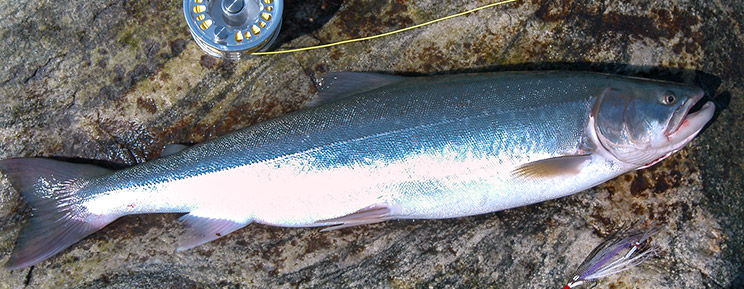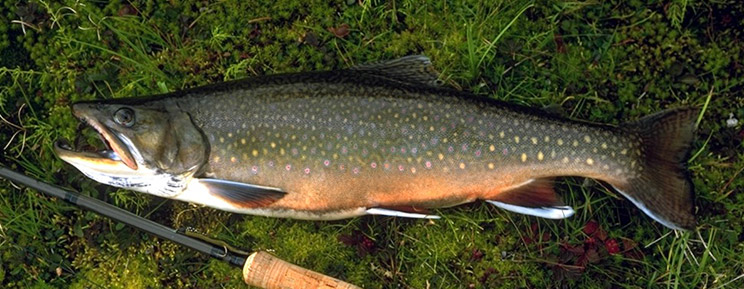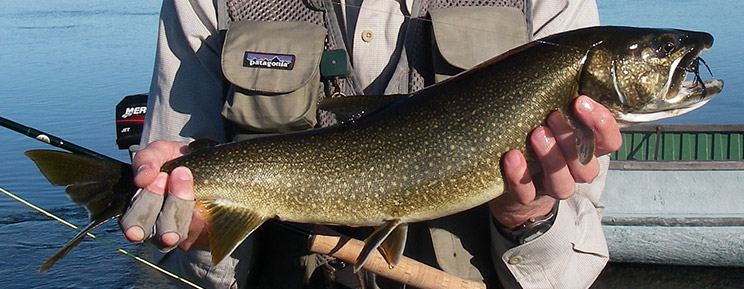
FISH SPECIES
Nunavik is the home to some of the best Arctic char and Brook trout fly fishing in Canada.
Arctic char
Other names: Iqaluppik (Inukttitut)

Average weight: Anadrome, 2,7 à 5,4 Kg (6 to 12 lbs)
Average weight: Landlocked, 1 à 2,25 Kg (2 to 5 lbs)
Record: Can grow up to 15 kg (33 lbs), in Nunavik
Almost exclusively a Northern fish, Arctic char is not well known among anglers. Yet once hooked, the fight it puts up easily rivals that of an Atlantic salmon. Arctic char swim out in long runs that challenge the skill of any angler as they try to throw his fly with characteristic, powerful shakes of its head and entire body.
Arctic char however, like other fish in Nunavik’s harsh climate, grow slowly. Fry, which are 25 mm (1 in) long on hatching, double in length during their first year. Three to five years later they have reached 8 – 15 cm (4 – 6 in) in length. At this stage, they join in summer migrations down-stream to the sea where there is an abundance of small fish (including sand lance and capelin) as well as shrimp. They feed voraciously for a number of weeks before returning inland to winter. To protect against predators, Arctic char is endowed with the ability to adapt its colouring to the different environments it inhabits, generally it is a dark colour in lakes and lighter shades while at sea.
Arctic char, like its cousin the salmon, may feed in the sea but always reproduces in freshwater. It reaches sexual maturity at age seven or eight when it measures up to 50 cm (20 in). During its spawning period from late September to early October, Arctic char boasts a bright red underside. Most mature Arctic char will not spawn on re-entering freshwater in the late summer. Rather, a whole year will be spent in its home lake before it moves to a spawning area the following fall. A year-round freshwater form of this species known as landlocked Arctic char (nutillik, in Inuttitut) can be found in some lakes.
Brook Trout
Other names: square-tail,aanak (Inukttitut).

Average weight: 1.5 to 2kg (3 to 4 lbs)
Record: Can grow up to Brook trout 4 kg (9 lbs) Sea-Run trout 4.5 kg (10 lbs), in Nunavik
Brook trout or Sea trout share many similarities with its cousin, the Arctic char. In particular, some populations, known as sea-run trout, will move to salt water estuaries in summer. As well, the Brook trout adapts its colouring to its environment. At sea, it is generally light green on the back with silvery sides, while in freshwater, a darker colour is displayed. Both Sea Run and freshwater Brook trout are easily identifiable by their reddish spots circled with a ring of blue referred to as halos.
Brook trout spawn in streams between August and October when water temperatures begin to drop and the amount of daylight shortens. Brook trout reproduce several times over the course of their seven to ten year life span. Brook trout are carnivorous and eat anything they can find and swallow, live or dead including small insects, fish and even small mammals.
Lake Trout
Other names: Lakers, grey trout and isiuralittaak (Inukttitut).

Average weight: 3.6 to 4.5 kg (8 to 10 lbs)
Record: Can grow up to Over 18 kg (40 lbs), in Nunavik
Lake trout which grow to weights in excess of 40 lbs, inhabit many lakes, rivers and streams in Nunavik. Lake trout have few predators beside themselves in the North and are voracious feeders gobbling parr, whitefish, Ciscoes, minnows, small fish, birds, animals as well as insects. A highly adaptive species, the Lake trout’s food source is limited only by the food found in each body of water, so don’t be surprised if a Lake trout decides to strike the Brook trout you are reeling in.
Like Arctic char and Brook trout, Lake trout are fall spawners and like other northern fishes, it takes many years for Lake trout to reach sexual maturity. They require cold, clear water and clean rock substrate for spawning.
Conservation of this Resource for Future Generations
Trophy fish are the elders of Nunavik’s underwater renewable resource and you are sure to hook more than one as they dart through their silent, discrete environment. It must be recalled, however, that the harsh climate of ice and snow has an impact on all wildlife in the region, fish included. Since they reach reproduction size much later in life than their southern cousins, the replacement rate of many fish species in the North is lower. Arctic char and Brook trout may only reproduce every two or three years, while Atlantic salmon spawns rarely more than twice over its life span. Consequently, conservation of large mature fish through catch and release is highly recommended. A single barbless hook and live release will preserve Arctic char, Sea Run trout and other fish stocks and allow future generations to share this unique experience.
Live Release Tips
1. A fish played for too long will be too exhausted to recover so play and release the fish quickly.
2. Keep the fish as much in the water as possible. Do not allow it to flop on the beach, rocks, or on the bottom of the boat. A few inches of water acts as a cushion to a thrashing fish.
3. Handle the fish as gently as possible and keep your hands wet. Never put your fingers in the gills or the eye. Lift smaller fish by the lower jaw; do not squeeze them. A rubber landing net can be helpful in keeping the fish in the water.
4. Carefully remove hooks with long-nosed pliers. Do not tear hooks out.
5. An unconscious fish may be revived by gripping it at the narrow part of the body just in front of the tail and at the same time cradle the fish in your other hand so as to hold the fish upright in the water. Draw the fish in a back and forth motion that forces water through the gills. Keep this motion until the fish revives. When it begins to struggle, release it.



